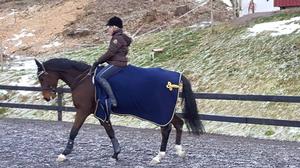Breed: KWPN
In July 2014 my horse Duncan, a 5 year old (at that time) KWPN talented jumper, suddenly started to refuse to move forward. We tried everything to find out what was wrong, every inch of the horse was checked, the saddle and bridle was checked, and we had 5 different vets to look at him and many different therapists. The horse was unrideable and showed really pain and anger if we tried to sit on him. After 1 year he started to show lameness in two legs. He got injections with cortisone in his right front knee and fetlock, and to his right hind knee. After new check 14 days later, he was still lame. New treatment, and still not sound in his front leg after the next 14 days.
Gave him a good rest period instead of treating anymore. At the same time we finally found out what he had been suffering from since July 2014, a damage on both sides of the sacroiliac joint was found. Both inflammation and some bone growth.
He was treated twice with cortisone injections, but it only lasted for 4-14 days each time. The vet was not very optimistic about this damage, and it was a big possibility that the front feet problems came from the pain in the back. Just after we gave up treating the sacroiliac joint, we saw that he had started to show lameness in the other front leg too. He was actually so lame that he didn’t limp in the front, because he didn’t knew which leg to limp on. We sedated the knees, fetlocks and coffin joints on both front legs, and he was still lame. After nerve blocking the coffin joints he finally got sound. The vet concluded with navicular syndrome. He asked me if I wanted to try Tildren, but I needed some time to think over it.
I had searched through “the whole Internet” to try to find a solution to all Duncan’s problems, and randomly I came over the ArcEquine. I had used lots of, lots of money trying to get this horse back on track, and I decided to give it a very last try with the ArcEquine. I ordered this little wonder, and my horse was the first horse in Norway to get this treatment
We started with the protocol that Ian gave us, and after about 3 months of using it every day it was finally time for the first trot. This was the first time in almost 2 years the horse moved forward under saddle, and he trotted like a champion!
Unfortunately, the happiness didn’t last many days. After 4 days he started refusing to move forward again, but this time it came from his front legs.
I think he was so happy to not feel the pain in the back anymore, but after a short while he couldn’t ignore the pain from the front legs any longer. I was a bit upset about the ArcEquine, which I thought had not been working on the damages in the front legs, only in the back.
But it was one more problem that we didn’t fully understand at that point, and that was the farrier. He left the toes too long, and the heels were very underslung, so the angle of the hooves worked against us. The back started to get worse again, and we was frustrated. The horse was turned out to see if anything could get better with rest and time. The vets was very negative, and told me the best to do was to euthanise him.
The same year, August 2016, Duncan fell in the field and got a fracture in his tibia (right hock). He got an operation a few days later and the pieced were removed, and also 50% of one the ligaments was damaged and had to be removed out.
When the horse was in the clinic for operation, the vets decided to take MRI of his front hooves to see the scope of the damages. The MRI pictures along with the experts who looked at them, found out that it had been a split in the deep digital flexor tendon and some formation to the surface of the navicular bone. All this probably caused by wrong angles of the hooves and a very bad farrier. The pictures luckily showed mainly scar tissue, so it had already healed!
The prognosis was relatively good, but it would take 3 months of box-rest and controlled exercise before we knew the outcome for sure. Meanwhile, he was suppose to have shockwave therapy and IRAP or cortisone injections into the damaged joint.
We did not treat the front legs anymore either.
Instead of doing as prescribed, we started using the ArcEquine immediately when the horse came back from the clinic. We left it on during every night on the 7hours program.
In the end of November, the vet came to see if he was sound. The horse was sound in all 4 legs for the first time in over 2 years!
We have now started to train him very carefully to make sure he stays sound in the future. He is full of energy and ready to start working again!











